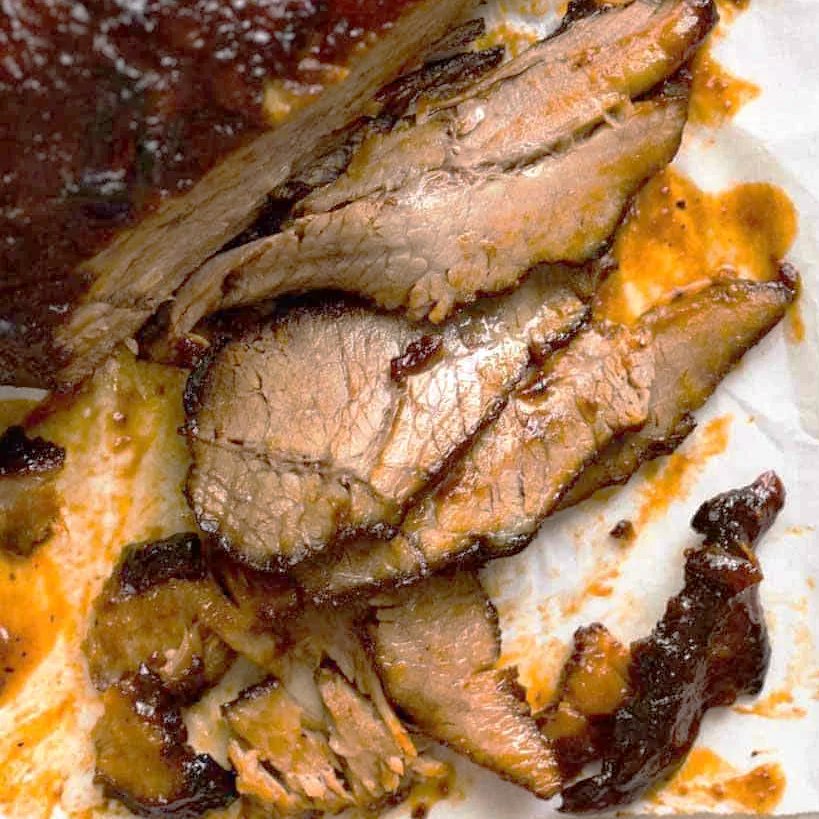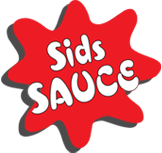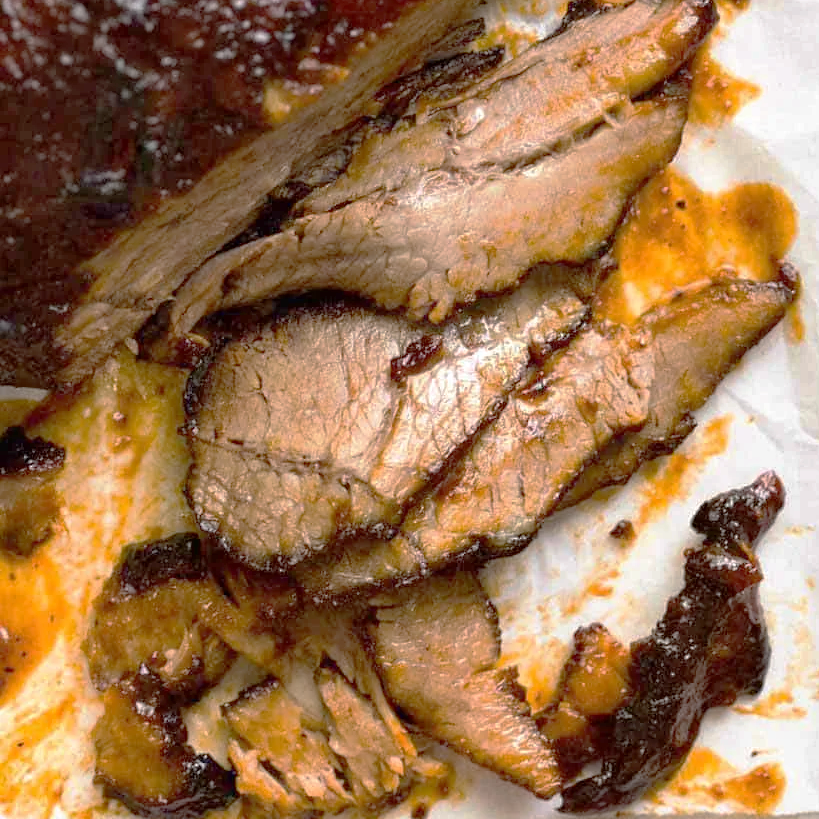Brisket Barbeque
Brisket Barbeque
Information on buying, preparing and barbequing BRISKET.
Ready in: All Day!
Serves: 12
Complexity: easy
kcal:
Share

Ingredients
Selecting the best brisket is a combination of skill and luck.
Remove the outside fat that will not render.
Trim the remaining fat. Sprinkle with SIDS CRAZY SALT.
Directions
Brisket is the most difficult meat to barbeque. It is naturally tough, contains two separate distinct muscles and is separated by a layer of fat that does not render. The meat absorbs smoke like a sponge so can become bitter very easily. It is so large that it requires long periods of cooking.
Selecting the best brisket is a combination of skill and luck. The meat comes from the chest of the cow, between and in front of the animals' front legs. It is used mostly for walking so is naturally tough. As such, it requires some careful consideration in selecting the best cut for eating.
The selection process involves not selecting the largest brisket (they are from old & tougher cows) but instead choose a cut from a medium sized cow, average 3-4.5 kg. Also, make sure the brisket is 'flexible' or 'pliable'. Place your hand under the centre of the brisket and let the brisket 'flop' over the edges of your hand. Select the one that has the most natural bend.
Remove the outside fat that will not render. It is hard, tough and often slightly yellow. It can be safely removed without affecting the tenderness of the meat. In this trimming, go down to the muscle so there is only a slight amount of fat remaining. It should look mostly red with a sprinkling of fat.
Trimming the Remaining Fat:- Go about 5 cm into the brisket in order to remove the maximum amount of fat yet keep the brisket whole. There is always a fat layer keeping the two muscles separate.
Turn over so the fat covering is on top. Trim this fat (using a large, sharp knife) to 6 mm all over.
SEASONING
I strongly recommend SIDS CRAZY SALT as your base seasoning. Add herbs & spices to taste if necessary.
Using a pastry brush, spread Dijon mustard all over both sides of the brisket. Reason being -
1/ Helps to keep the meat moist.
2/ Helps to seal the meat and set up a tender crust.
3/ The vinegar in the mustard will help to slightly tenderise the meat.
4/ Helps to keep the dry rub on the brisket.
A good idea is to use a cheap 'sprinkle dispenser', available from most supermarkets, to apply the rub. It has holes large enough for large bits of herbs.
Cover the meat thoroughly with your rub. It will become a 'wet' rub quickly so be careful when handling and avoid removing any of the rub.
COOKING PREPARATION
Brisket can not be cooked like Pork!
Pork is quite 'forgiving' when it comes to the use of excessive smoke from various sources. NOT SO WITH BRISKET! Reduce smoke flavouring to almost zero or run the risk of a bitter flavour. Brisket is very much like a sponge in this respect.
USE ONLY WOOD THAT HAS BEEN BURNED DOWN TO COALS OR CHARCOAL THAT HAS BEEN BURNED DOWN TO GREY ASH.
DO NOT USE GREEN WOOD, WHOLE LOGS OR UNBURNED CHARCOAL. ALL OF THESE METHODS WILL PLACE TOO MUCH SMOKE FLAVOUR IN THE MEAT.
IF USING GAS, THERE IS NO PROBLEM.
Use a charcoal chimney when using charcoal and/or a special 'burn pit' to burn down any wood you may use. Once you have grey ashes or red coals from the wood, use a shovel and gently place the charcoal/coals in the pit. It is a pain, but it is well worth doing.
Check your Thermometer - dunk the sensor in boiling water to calibrate. If it does not read 100°C, note the reading and compensate.
COOKING
The thermometer in your pit should be reading about 110°C for barbeque. This temperature should be read at the same level in the pit as the meat. Do not rely on the readings from the thermometers that are supplied in the lid of a gas barbeque. They are cheap and wildly inaccurate with no repeatability. It is best to drill a hole to fit a quality temperature probe in your gas BBQ or pit. Ensure, however, that the probe is not above the direct heat source.
Cooking temperature should be 100-110°C. Time will vary on the size of the meat. Usually a 5 kg brisket will take 9-11 hours. It is a matter of practice and experience.
The meat should be cooked to well done - not pink.
When cooking brisket, place the meat as far away from the heat source as possible. This provides for stable cooking temperatures. If it is too close to the heat source, then one side will be cooked at a higher temperature than the other, causing varying tenderness. If you have a smaller pit (Weber Kettle) then place the charcoal on one side of the pit and the meat on the other. You will then have to rotate the meat every 30 minutes or so, (preferably when you baste the meat) to keep temperatures consistent. If you are using a vertical cooker, try using some type of pan under the meat to catch the juices (to prevent flaring) and to act as a diffuser for even temperature cooking. A pan with about 6 mm of water is great for this purpose and will keep the juices from scorching and flavouring the meat with a burnt taste.
BASTING:
Do not baste at first. Allow the rub to thicken up, become a lot dryer and be 'one with the meat' before basting. Baste only when a crust has formed, about 2-4 hours. Basting prior to this will only result in washing off the rub.
Best way to apply the baste is either using a mop or a spray.
Mop:- Has a 30 cm handle with cotton tassels at the end just like a miniature household floor mop. It is great for soaking up lots of liquid then quickly and gently 'dabbing' the sauce on the meat. Use if your baste has solids like crushed garlic etc. DO NOT RUB! That will remove the glaze you have tried so carefully to create.
Spray:- A spray bottle can handle only pure liquid with no solids.
NEVER USE TOMATO BASED PRODUCTS TO BASTE THE BRISKET AS THEY WILL BURN AND BECOME VERY BITTER, LONG BEFORE THE MEAT IS READY!
When your brisket is done, remove from the heat, carve in the normal way and serve with your favourite vegetables etc.

